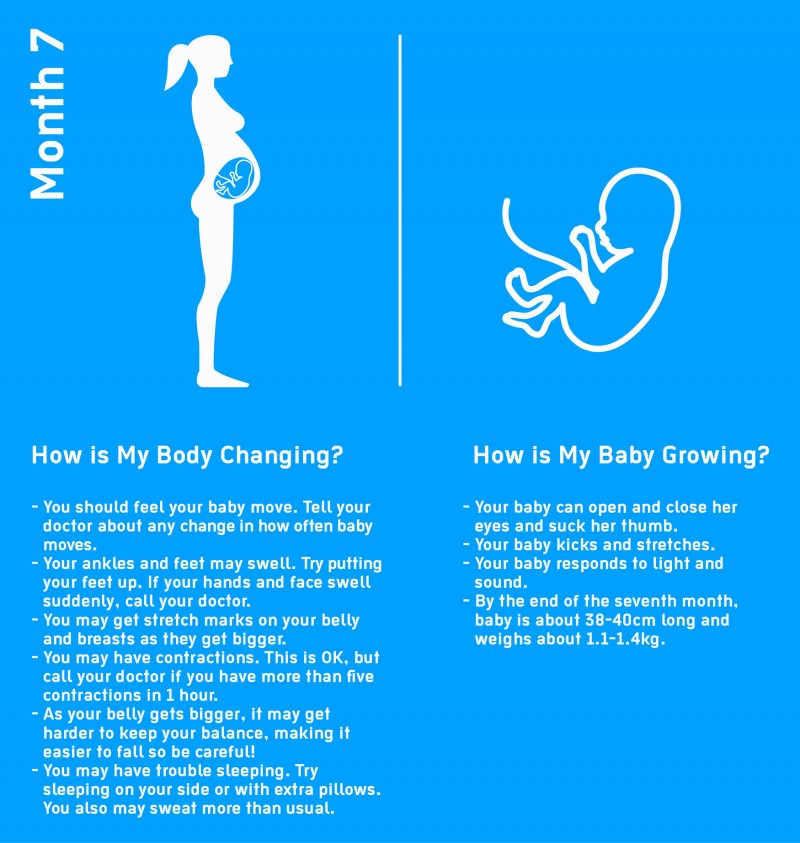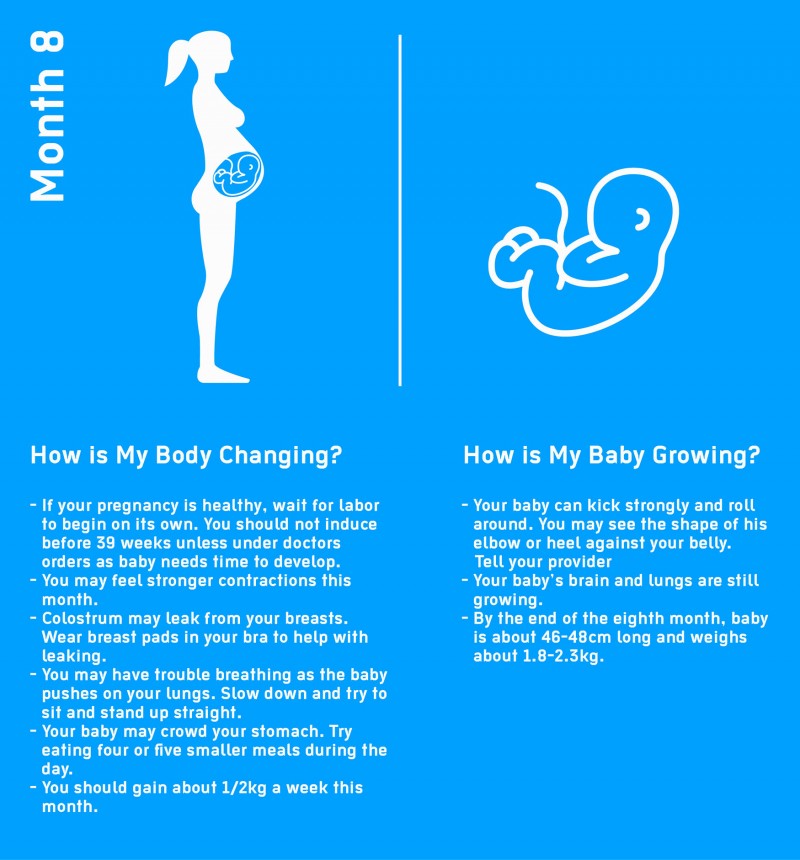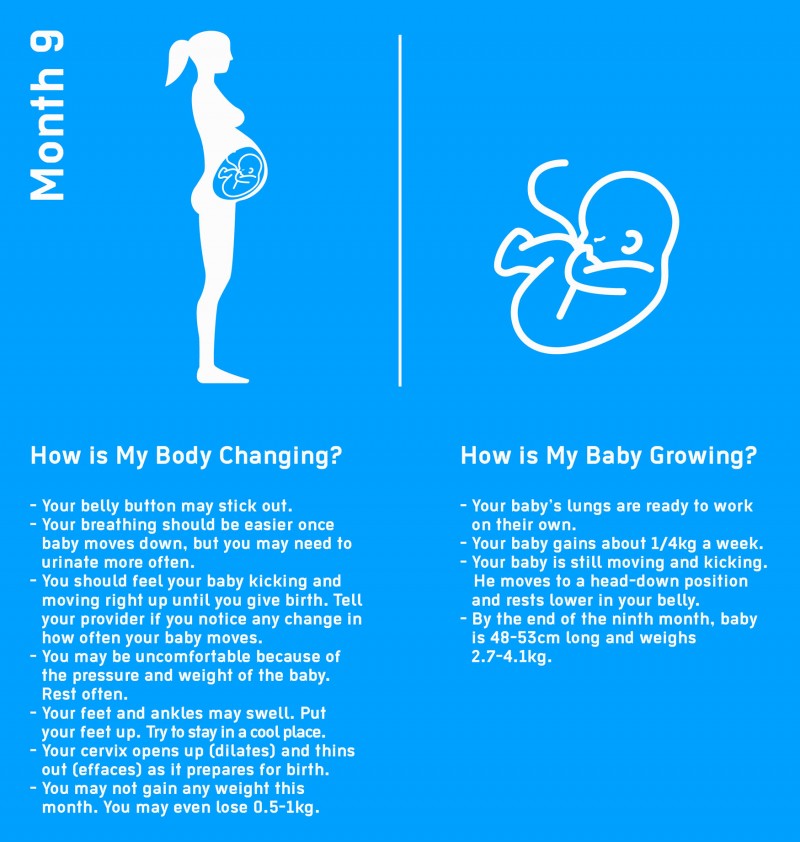How is my body changing and my baby growing?
Should I count my baby’s kicks?
Yes, starting at 28 weeks spend some time each day counting baby’s kicks to make sure she is moving enough. Here is a step-by-step guide:
- Count the kicks every day, preferably at the same time. Pick your time based on when your baby is usually active, such as after a snack or meal.
- Make sure your baby is awake first; walking, pushing on your tummy or having a cold drink are good wake-up calls.
- To get started, sit with your feet up or lie on your side. Count each of your baby’s movements as one kick, and count until you reach 10 kicks.
- Most of the time it will take less than a half-hour, but it could take as long as two hours.
For more information go to
Count The Kicks.
What do we need to have ready for baby?
Here are some essentials you will want to have ready before the baby comes:
- Clothing – 6-8 all-in-ones, 6-8 vests or T-shirts, 2-4 hats, 1 heavy all-in-one suit or jacket (in winter), and 4-6 receiving blankets.
- Diapers - plan on using about 70 diapers a week.
- Sleeping – a crib or cot with a snug fitting mattress.
- Feeding – if you are breastfeeding then nothing, but if using formula you will need bibs, bottles, teats, bottle-brushes and way of sterilizing (this is vital).
- Bathing – baby bath and/or newborn bath support, soft washcloths and towels, and mild baby soap.
- Moving – car-seat if traveling by car. Not essential but handy are a baby carrier and stroller.
What is false labor?
Also called Braxton Hicks contractions, this is a painless tightening in your lower abdomen. Some women never feel them, and others can start feeling these Braxton Hicks contractions in their second or third trimester of pregnancy, but they typically get stronger in the last month of pregnancy. They do not mean you are going into labor; it is just your body’s way of getting prepared. There are a few signs that differentiate true labor from false labor:
|
Real Labor
|
False Labor
|
- Contractions are regular and come at increasingly shorter intervals and become longer and more intense.
|
- Timing of the contractions are irregular and do not become more frequent or more intense.
|
- Breaking of waters that result in a trickle or a gush of fluid. Contractions may start before or after.
|
- Contractions stop during rest, when mother stops what she is doing, walking, or changing position.
|
- Passing the mucus plug. Labor could still be a few days away, but it is coming.
|
- Contractions are inconsistent in strength (strong one minute then weak the next).
|
- Persistent pain in the lower back, especially if accompanied by a cramping, premenstrual feeling.
|
- Location of pain is in the front only.
|
What are some danger signs?
If you have any of these signs, immediately contact your doctor or go to the hospital as they may indicate a major threat to you and/or your unborn child:
- Severe and/or constant abdominal pain.
- Vaginal bleeding, especially bright red blood.
- Severe, uncontrolled vomiting that causes dehydration.
- Headache, dizziness, or double vision or blurred vision for 2-3 hours.
- Chills and / or high temperature (38ºC or more).
- Sudden and severe swelling of the face and the hands and feet, and/or unexplained weight gain.
- Unusually slow or no movement of your baby after the sixth month.
Prenatal Tests
You should visit your doctor at least two-to-three times during the third trimester. Whether or not you are asked, tell your doctor about all of your symptoms, even if they seem normal, like tiredness or aches and pains. Do not let your doctor rush through your appointment or make you think they are too busy. Yes, they may be busy, but your pregnancy is still the most important thing in the world to you.
The following is what you can expect from prenatal visits in the second trimester:
|
31-34 weeks:
|
- Health check with questions on problems or concerns since last visit.For example, how you have been feeling e.g. any contractions, headaches or swelling?, how your baby is moving. Doctor will listen to baby’s heartbeat and examine your belly to estimate baby’s size and position (an ultrasound can also perform these checks, in addition to other fetal checks). Doctor will measure your weight and blood pressure.
- Possible exams/tests might include a pelvic exam if doctor has concerns e.g. preterm labor or to check your baby's position. Doctor might also check your urine if necessary.
- Counseling by the doctor on taking care of your health, warning signs, changes to expect before your next visit, and keeping track of your baby’s daily movements.
|
|
36-38 weeks:
|
- Health check with questions on problems or concerns since last visit, how you have been feeling, how your baby is moving. Doctor will listen to baby’s heartbeat and examine your belly to estimate baby’s size and position (an ultrasound can also perform these checks, in addition to other fetal checks). Doctor will measure your weight and blood pressure.
- Counseling by the doctor on taking care of your health, warning signs, signs of impending and active labor (including when to call doctor or go to hospital), changes to expect before your next visit, and keeping track of your baby’s daily movements.
- Lab tests to check urine (protein levels), vaginal swab (StrepB test).
|
|
40-41 weeks:
|
- Health check with questions on problems or concerns since last visit, how you have been feeling, how your baby is moving. Doctor will listen to baby’s heartbeat.
- Pelvic exam to check softening or dilation of your cervix.
- Counseling by the doctor on when and how to induce your labor.
|
*The amount you see your doctor will depend on your medical history and if there are any complications that require more checkups. The WHO recommends a minimum of four prenatal visits around weeks 16, 24-28, 32, 36 for uncomplicated pregnancies. However in many countries, women go every month to the doctor, and every week during their last month of pregnancy.
^Together, the blood test and the ultrasound are known as the first-trimester combined screening, which provides a risk assessment of the fetus having Down syndrome as well as other chromosomal problems and birth defects. These tests are optional; you can agree or refuse to have them. These tests are not definitive, but provide a relative likelihood of the fetus having a genetic defect. There are two diagnostic tests that provide a certain result: 1) Chorionic villus sampling (CVS), done at 11-12 weeks; or 2) Amniocentesis, done at 16-20 weeks. These tests are invasive and carry a small risk of miscarriage, so they are typically only performed when the woman shows a higher risk for genetic and chromosomal problems. Your doctor will advise you if an invasive test is necessary, but again this test is optional and it is entirely your decision to have one or not.
Category: Third trimester


